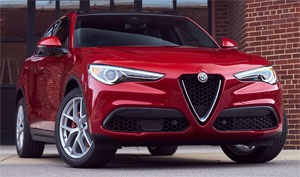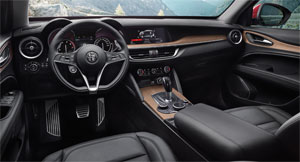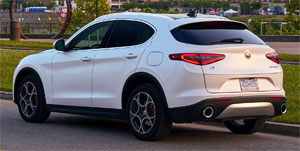2018 Alfa Romeo Stelvio
While the Giulia did a lot to cement Alfa Romeo’s place in the euro luxury-sport market here, these days no brand can really compete stateside without an SUV. And indeed, the Stelvio was always a part of Alfa’s return strategy to America. So, let’s take a look at this upstart utility and find out why more familiar European brands should be getting a little nervous.
The 2018 Alfa Romeo Stelvio is indeed the right vehicle at the right time, as even with luxury-sport brands, utility vehicles continue to take sales away from sedans. So it’s not just a good idea for this re-emerging Italian brand, it’s really a necessity.
And while no one may have seen that coming 20-years ago, it almost makes sense at this point; as car makers have been able to infuse utilities with the same amount of performance, comfort, style, and even efficiency as their 4-door siblings, while giving buyers more flexibility for carrying cargo.
Behind the wheel of this Italian two-row ute, things are very quiet and luxurious. It’s very stable; and like most of its competitors, drives more like a tall hatchback than a crossover-style utility.
Seats are more than comfortable, but if you don’t mind a sportier ride, upgrading to the Ti Sport will get you some phenomenal sport seats.
 For now, all Stelvio’s come with a smooth-running 2.0-liter turbo I4 engine. It offers best in class standard horsepower at 280, accompanied by 306 lb-ft. of torque. At full song, it sounds more like an exotic 6 or even 8. In opposite fashion from the Giulia sedan that the Stelvio is based on, we’ll have to wait a little while longer for the high-performance Quadrifoglio version to arrive.
For now, all Stelvio’s come with a smooth-running 2.0-liter turbo I4 engine. It offers best in class standard horsepower at 280, accompanied by 306 lb-ft. of torque. At full song, it sounds more like an exotic 6 or even 8. In opposite fashion from the Giulia sedan that the Stelvio is based on, we’ll have to wait a little while longer for the high-performance Quadrifoglio version to arrive.
Huge column-mounted paddle shifters are available to control the 8-speed automatic transmission with great precision; and if you ask for manual control, that’s what you get. All Stelvios are all-wheel-drive.
It doesn’t feel leaps and bounds more spirited than the competition, at least without having the opportunity to drive them back to back; but it sure does feel hellaciously fast and super capable. 0-60 is 5.4-seconds, and only a few ticks behind the Giulia 2.0.
Like Giulia, there’s a DNA drive mode selector. Leave it in Dynamic for the best results, and you won’t find the ride harsh at all.
Steering is quick, it feels planted and just right; with loads of grip for cornering.
 With Alfa’s Q4 all-wheel-drive system, the front wheels only are fed power when necessary, otherwise it operates as a rear-wheel-drive sportster.
With Alfa’s Q4 all-wheel-drive system, the front wheels only are fed power when necessary, otherwise it operates as a rear-wheel-drive sportster.
Now, Stelvio performs just fine in all other drive modes as well, it just kind of gives you the impression that’s not where it wants to be.
At 111.0-inches, wheelbase is exactly the same as the Giulia, but with a little more material outbound, overall length comes in about two inches longer.
For the most part it shares the same aggressive face, but lines are a little more pronounced, especially down the sides.
There are 9-different tire and wheel packages, ranging from standard 18s to 20s.
Even the back end treatment is gorgeous. We almost whish Alfa would have just called it a Giulia wagon, even though we all know to most Americans that would kill it.
 Base Stelvios come fairly well equipped, but most buyers will either travel down the Lusso or Sport road for upgrades that match their priorities; wood and nicer leather for the luxury-minded, aluminum trim for the sport-minded.
Base Stelvios come fairly well equipped, but most buyers will either travel down the Lusso or Sport road for upgrades that match their priorities; wood and nicer leather for the luxury-minded, aluminum trim for the sport-minded.
Like the Giulia, there are only minor traces of any Fiat-Chrysler lineage; materials and fit and finish are on par with European alternatives. It’s a very inviting space, with only a fussy electronic shifter to detract from the serenity.
Rear seat room is not plentiful, but certainly doable for two adults. Capacity in the cargo hold, at 18.5 cubic-ft. is decent, but short of most rivals. Folding the rear seatback will expand the space to 56.5 cubic-ft.
Also like the Giulia sedan, the Stelvio is technically mid-size, but lies more in the middle ground between compact and middle-weight SUVs.
Government Fuel Economy Ratings are 22-City, 28-Highway, and 24-Combined. For a reasonable Energy Impact Score of 13.7-barrels of yearly oil use with 6.0-tons of CO2 emissions.
Stelvio base pricing is a very reasonable $42,990, though options are many and costly. We figure most Stelvio’s will go for low to mid 50’s.
According to the folks at Alfa, there was no point in adding yet another utility vehicle into a congested pool full of very nice import and domestic-branded luxury crossovers; unless it was the most powerful, highest-performing vehicle in its class. The 2018 Alfa Romeo Stelvio is just that. It’s a fabulous effort. So, Alfa’s biggest challenge will be getting butts in seats to try it out. Once they do, Stelvio will sell itself.
Specifications
- Engine: 2.0 liter
- Horsepower: 280
- Torque: 306 lb-ft.
- 0-60 mph: 5.4 seconds
- EPA: 22 mpg city / 28 mpg highway
- Energy Impact: 13.7 barrels of oil/yr
- CO2 Emissions: 6.0 tons/yr
2024 Polestar 2
More Range And More Power For The Polestar 2
Volvo is well on their way to making the transition to an all-electric brand, but their sister-brand Polestar is already there. Now, we’ve spent lots of time in their all-wheel drive, five-door Polestar 2, having tested it in 2021, and a year later when a two-wheel drive version arrived. But, EV updates are coming quickly. So, let us be your guide for all that’s new with the Polestar 2.
While we are driving more EVs than ever, we’ve also been spending a lot of time recently circling back to ones we’ve previously tested. As in this new era of electrified vehicles, significant updates are arriving quickly, with R&D investments increasing and retrofitting them easier than ever. This is often done through software updates that can even be accomplished over the air. For 2024, the Polestar 2 has indeed gotten some software updates, but some physical ones as well.
Clearly aimed directly at Tesla’s Model 3 when it arrived; the Polestar 2’s build quality was vastly better, but range definitely came up short. So, addressing that was priority No. 1; and for ’24 the Polestar can travel up to 20% farther than before while consuming 9% less energy, and when it comes time to charge it back up, it can do that 34% faster too.
Range in the Single Motor version increases from a max of 270 to 320 miles thanks to a larger 82-kWh battery pack, and that solitary motor now powers the rear wheels, not the front wheels. It’s also bigger, coming in at 220 kW compared to the previous 170 kW front-wheel drive version, going from 231 to 299 horsepower.
Dual Motors keep the same 78-kWh battery, but still sees a boost from 260 to 276 miles and takes advantage of the larger rear motor for a new combined 310-kW output with 421 horsepower. Our test car has the added Performance Pack, which uses an additional 35 kW to deliver 455 horsepower and 546 lb-ft of torque, though max range drops to just 247 miles.
The new battery in rear-drive 2s will also charge faster, now accepting up to 205 kW for an 80% charge in 20 minutes; max for dual-motors stays at 155 kW, which puts an 80% charge at 34 minutes. Using 32 kWh of electricity per 100 miles, the Dual Motor earns a good efficiency rating.
The [Polestar] 2 has always been one of the most enjoyable EVs to drive, even more so now with that additional power coming from the rear motor.
Unfortunately, extremely cold temperatures kept us from seeing that increased range, as we were only on pace for about 194 miles in our test.
The 2 has always been one of the most enjoyable EVs to drive, even more so now with that additional power coming from the rear motor. And especially when equipped with the Performance Pack as it not only includes more power, but adds 20-inch forged wheels, upgraded brakes, and adjustable Ohlins Dual Flow Valve performance dampers. It greatly improves handling prowess without affecting ride quality, and is easily worth the $5,500 charge if you at all enjoy driving.
Even on a 20-degree track day there was plenty of grip through our handling course. No understeer or oversteer, and lots of feedback through the wheel. There was a nice, strong launch off the line that properly planted us firmly in the seat, and rocketed us to 60 in 4.5 seconds. Power delivery stayed pretty intense up until about 80 mph when there was a definite tapering off. Still, it was a 13.4-second quarter-mile at 102 mph; smooth, quiet, and stable the whole way.
When this car debuted, its Google-based infotainment setup was a novelty, but since then, more and more manufacturers are just “Googling it” so it doesn’t seem out of place at all. The wireless phone charger is easy to access, and there’s a great Harmon/Kardon sound system and panoramic sunroof to enhance the in-cabin experience. Exteriors have also been enhanced with a smooth grille insert and new wheel choices.
Hatchback practicality means 14.3 cu-ft of easy to access cargo space with split-folding seatbacks for longer items and expanding the space to 38.7 cu-ft. Plus, there’s even a sizeable storage bin up front under the hood.
Single Motor Polestar 2 pricing now starts at $51,300, with Dual Motors starting at $56,700; topping out at $64,400.
For a car manufacturer that hasn’t even been around for a decade yet, Polestar has kept itself busy, totally transforming their latest model in just a few years, making the 2024 Polestar 2 even more appealing. They are certainly off to a good start, and with a host of Polestars just over the horizon, including some all-important utility vehicles, this star will be shining even brighter.
Specifications
As Tested
- Motor Setup: Dual Motor
- Horsepower: 455
- 0-60 mph: 4.5 seconds
- EPA Range: 247 miles
- Efficiency : 32 kWh / 100 miles
- Battery Size: 78-kWh
- Torque: 546 lb-ft
- 1/4 Mile: 13.4 seconds at 102 mph
- MW Test Loop: ~ 194 miles
- Peak Charging Rate: 155 kW











































